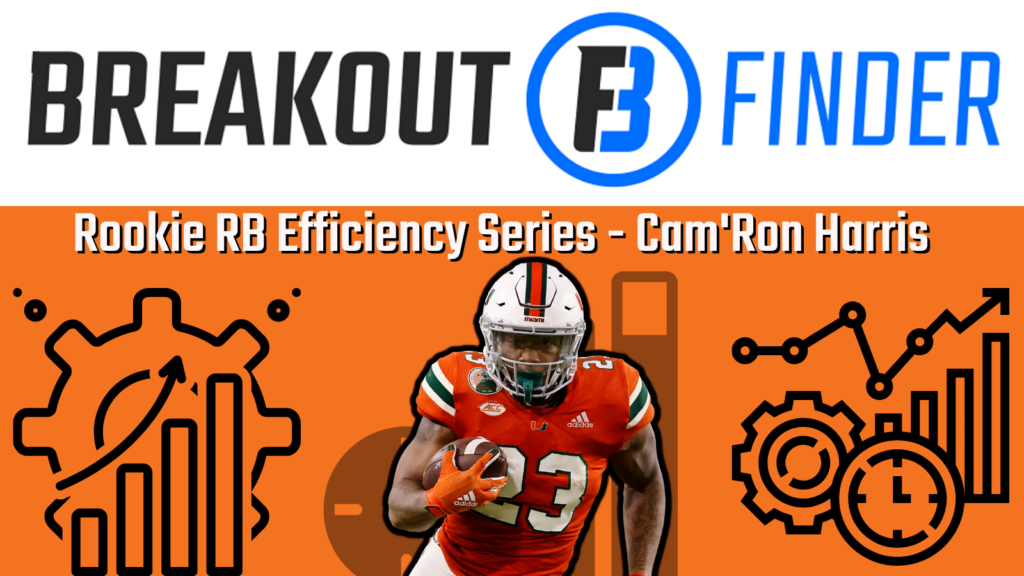Miami’s Cam’Ron Harris is the next subject in a series in which I evaluate 2022 rookie running backs solely on their ability to run the ball. The Breakout Finder installments can be found here. The five PlayerProfiler installments can be found here. If you happened to already catch those and don’t need a refresher on my methodology, feel free to skip to the player-focused analysis.

The University of Miami has been churning out completely blah running back prospects like they’re a sub-tier streaming service producing original series’ in the last few years. I know some of y’all were on the DeeJay Dallas, Travis Homer, and Mark Walton trains. Don’t lie. Cam’Ron Harris is the next in that line.
Harris (previously Davis) spent four years at the U and never was particularly productive. The 20.5-percent Dominator Rating he posted as a junior is his career best. And even that mark is below average when adjusted for age. He was playing with relatively talented teammates; their collective 3.62-star average rating as high school recruits is a 67th-percentile figure among teammates of backs drafted since 2007. And he did manage to outperform them from a rushing efficiency standpoint.
The Metrics
On 339 total carries (less than 10 per game), Cam’Ron Harris outpaced other Hurricane backs by 0.42 yards per carry and 1.75-percent in Chunk Rate. These numbers land in the 46th and 59th-percentiles, respectively. As an open field runner, he was pretty decent. He converted a 68th-percentile amount of his chunk gains into breakaways of 20 or more yards, at 34.4-percent.
He did all this while facing box counts that were heavier on average than those his teammates were running against. There were 0.06 more defenders near the line of scrimmage on his carries vs. those of other ‘Cane runners, a 59th-percentile discrepancy. Against each individual box count, he was pretty consistently beating the per-carry output of those other Miami running backs,. The only front against which he had a lower average was 6-man boxes. There, he gained 5.67 yards per carry vs. 5.71 for his backfield mates. On the aggregate, the average Harris carry was worth 114.0-percent the yardage of the average non-Harris carry. While positive, that BAE Rating is not impressive relative to those of historical prospects, landing in just the 41st-percentile.
Rushing Efficiency Score and Comps
Overall, Cam’Ron Harris’ efficiency profile is good but not great; reflected by the 56.0 out of 100 that he earns in my running back model’s composite Rushing Efficiency Score (which accounts for all the non-BAE metrics touched on here, in addition to overall team quality, offensive line play, opponent strength, and rushing volume). In a BAE-centric composite score, he earns a 54.6.
Using the same inputs as the Rushing Efficiency composite (in addition to physical measurables), my running back model also generates comps for prospects in the “pure runner” category. Based on this research, we should expect him to be about 5-9 and 211-pounds at the Combine. Assuming he runs a 4.50 40-yard dash, the following players would be his most similar runners among historical prospects:

All at 85-percent or greater similarity, these comps are relatively clean. For the most part, they paint a picture of a quality college running back who we shouldn’t have high expectations for as he transitions to the next level. Christian McCaffrey is the clear outlier. While his rushing efficiency profile is undeniably very similar to Harris’, McCaffrey posted those similar numbers on much greater volume and was obviously a far superior receiver coming out. The rest of these guys seem to represent a fair range of outcomes for a prospect like Harris.
Last Word
Cam’Ron Harris has got fine size and was a decent college player. But without possessing any traits that truly set him apart, he is probably somewhere between a special teamer and a third-on-the-depth-chart kind of guy. I see healthy scratches in his future.
